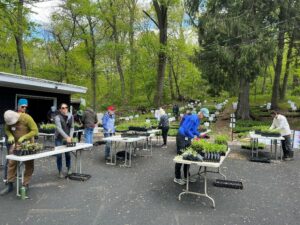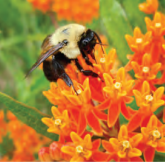Native Plants Home
Welcome to GSWA’s Plant for Pollinators program!
Get email updates on the 2025 Plant for Pollinators program
To ensure you don’t miss any updates, make sure you’re on our Native Plant Mailing List. Subscribers receive vital program details, including webinar reminders, helpful gardening tips, pickup instructions, as well as volunteer opportunities. Don’t miss out—CLICK HERE to join or update your subscription!
Your 2025 plant ordering process
We’re keeping it simple! This year, you’ll enjoy the same user-friendly ordering platform as last year. You’ll be able to browse, purchase, and plan with ease—whether you’re ordering Garden Kits, Individual Species, or additional Native Plant Program items. Preview links for the plant catalog and sale can be found below.
As the program grows, we will be adding links and resources to this page in the coming days. Stay tuned, and thank you for taking an active role in preserving our environment! For specific questions about plants or garden designs, reach out to us at plantsale@greatswamp.org. For technical inquiries, please contact nrago@greatswamp.org.
How to get started—We are LIVE!
Step 1: Explore the Native Plants Catalog
- Option 1: Use the Downloadable Interactive Native Plant Catalog for detailed searches right from your desktop.
- Option 2: Use the Online Native Plants Overview, a fully mobile-friendly and accessible on your smartphone or desktop.
Step 2: Plan Your Native Garden
- Plan ahead by selecting the plants you want to order and choosing your preferred 2025 Pickup Location. To stay organized, use our Printable Planning Sheet—it’s designed to help you map out both Garden Kits and Individual Species for a thriving, well-structured landscape.
Important Pickup Location Details to Know:
-
-
If your town’s scheduled pickup dates and times don’t work for you, below are two options to consider when completing your order during the Native Plant Sale checkout process, which opens on April 1 at noon.
PREFERRED – Select the desired town from our list of 2025 Pickup Locations and have a family member or friend pick up your order on your behalf. Just be sure to give them a copy of your order confirmation email, which you’ll receive upon completing your order. This confirmation will help our native plant partners with on-site organization and expedite your pickup process.
ALTERNATE – Select GSWA HQ as your pickup location. Once you receive your order confirmation email, forward it to nrago@greatswamp.org along with your preferred pickup date and time between Monday, May 5, and Friday, May 9, from 9 AM to 5 PM. If you need a time outside of office hours, just let us know—we’ll do our best to accommodate! We keep track of all special requests and store orders in a deer-proof area to keep your plants safe. -
Pickup Location Changes: Unexpected pickup location changes can only be made under special circumstances and must be moved to GSWA HQ. Requests to modify pickup locations to GSWA HQ must be submitted by the close of business on Wednesday, April 24, by forwarding your confirmation email to nrago@greatswamp.org along with your preferred pickup date and time between Monday, May 5, and Friday, May 9, from 9 AM to 5 PM.
-
Orders not picked up by Friday, May 9, may be forfeited without a refund. Please do your best to pick up your order at your selected location on the assigned date and time.
-
Step 3: Place Your Native Plant Order
- Starting April 1 at noon, 12:00 PM, CLICK HERE for access the Plant Sale Order Form to complete your plant order and select one of the 2025 Pickup Locations, Important: Choosing one of 17 designated partner-operated locations is required when placing your order.
- Plant Sale Closes on April 18 at 5:00 PM.
Orders close on April 18 at 5:00 PM.
Step 4: Pickup Your Plants
- Mark your calendar! Pick up your plant order at your chosen location on May 3/4 during their designate times. NOTE: Once you submit a pickup location, changes can only be made for special circumstances and moved to the GSWA HQ pickup location. Please see the above instructions.
Garden Kit Manuals
Each of the six garden kits comes with a garden owner’s manual packed with guidance on your new pollinator garden, complete with sample planting designs, seasonal maintenance schedules, pollinator information and more. Download the manuals early to help you prepare your garden.
- Dry Shade Manual (Separate PDF)
- Dry Sun Manual (Separate PDF)
- Moist Shade Manual (Separate PDF)
- Moist Sun Manual (Separate PDF)
- Powerhouse Manual (Separate PDF)
- Rain Garden Manual (Separate PDF)
Let’s prep for our pollinators!
Mark your calendar for our highly-anticipated “Plant for Pollinators” webinar series as we once-again turn our attention to native plants and the essential role pollinators play in the ecosystem. In partnership with our plant program partners and led by nationally acclaimed experts, we are offering four new hour-long, information-packed webinars leading up to our 5th annual, online Native Plant for Pollinators sale running April 1-18.
Volunteer Opportunity: Plant Processing Week


Help us prepare for this year’s sale by signing up for a volunteer shift during our Plant Sale Factory Days April 28-May 2! Your time and energy are essential to making this program a success. CLICK HERE to volunteer today!
An overview of 2025 offerings—We are LIVE!
- Plant Sale Opens: April 1 at noon, 12:00 PM. CLICK HERE for the Plant Sale Order Form.
- Before April 1, use the downloadable Interactive Native Plant Catalog to explore the Garden Kits, Individual Species and Additional Items that will be available, and the downloadable Printable Planning Sheet to easily organize your thoughts while simplifying your ordering experience.
- Every plant in the program serves a purpose: providing critical habitat and food sources for pollinators. While our Plant – Pollinator Interactions highlights many of these beneficial relationships, the truth is, the connections between native plants, wildlife, and pollinators are virtually endless.
- Plant Sale Closes: April 18 at 5:00 PM
- Order Pickup: Order pickup in on May 3, with plants distributed locally to your chosen partner-operated pickup location. At checkout, you’ll need to select one of 14 local sites to finalize your order. Please note that your selection cannot be changed after submission. Explore our 2025 Pickup Locations, available through our trusted 2025 native plant partners, and plan ahead! (Locations subject to change.)
Why Native Plants Matter
The Plant for Pollinators Program goes beyond cultivating beautiful gardens—it’s about restoring life to our ecosystems. By planting native species, you’re creating essential habitats for pollinators and birds, strengthening the web of life that sustains our local environment. Together, we can transform our backyards into what acclaimed entomologist Doug Tallamy envisions as a “Homegrown National Park™”—one garden at a time.
Finding the right native plants for your garden can feel challenging. That’s why we simplify the process by offering a curated selection of plants specifically suited to our local soils and climate.


But why are native plants so critical compared to exotic or non-native varieties? While non-native plants may produce seeds or berries consumed by wildlife, they often lack the full nutritional value animals need to thrive. Pollinators and other wildlife evolved alongside native plants, relying on them for food, habitat, and reproduction throughout their life cycles. For instance, pollinator insects depend on native plants not only for nectar and pollen but also as hosts for laying eggs and feeding larvae. Many species, like the monarch butterfly, are entirely dependent on specific plants—milkweed, in their case—for survival.
This connection ripples across the ecosystem. Healthy insect populations form the foundation of the food web, supplying birds and other wildlife with the protein-rich diet they need to reproduce. Research even shows that areas require at least 70% native vegetation to support species like chickadees. Without native plants, our ecosystems simply cannot sustain themselves.
This program thrives through a collaboration between the Great Swamp Watershed Association, 15 local towns, and 10 non-governmental organizations. With their partnership—and your participation—we’re building a greener, healthier future. Join us today!
